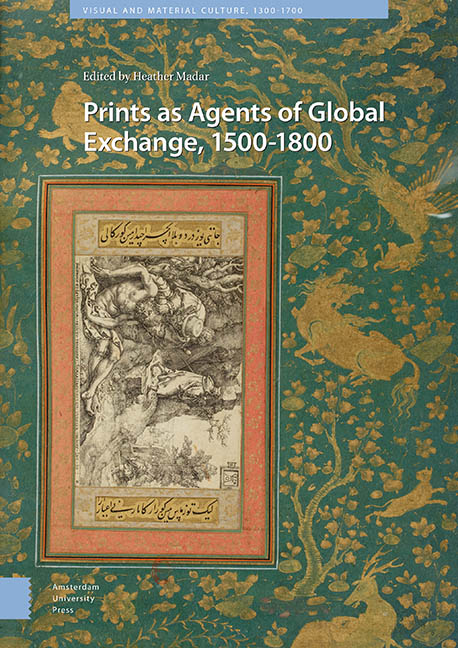Book contents
- Frontmatter
- Table of Contents
- List of illustrations
- Introduction
- 1 Concealing and Revealing the Female Body in European Prints and Mughal Paintings
- 2 The Sultan’s Face Looks East and West: European Prints and Ottoman Sultan Portraiture
- 3 From Europe to Persia and Back Again: Border-Crossing Prints and the Asymmetries of Early Modern Cultural Encounter
- 4 The Dissemination of Western European Prints Eastward: The Armenian Case
- 5 The Catholic Reformation and Japanese Hidden Christians: Books as Historical Ties
- 6 (Re)framing the Virgin of Guadalupe: The Concurrence of Early Modern Prints and Colonial Devotions in Creating the Virgin
- 7 Hidden Resemblances: Re-contextualized and Re-framed: Diego de Valadés’ Cross Cultural Exchange
- 8 The Practice of Art: Auxiliary Plastic Models and Prints in Italy, Spain, and Peru
- 9 Ink and Feathers: Prints, Printed Books, and Mexican Featherwork
- Index
6 - (Re)framing the Virgin of Guadalupe: The Concurrence of Early Modern Prints and Colonial Devotions in Creating the Virgin
Published online by Cambridge University Press: 16 December 2021
- Frontmatter
- Table of Contents
- List of illustrations
- Introduction
- 1 Concealing and Revealing the Female Body in European Prints and Mughal Paintings
- 2 The Sultan’s Face Looks East and West: European Prints and Ottoman Sultan Portraiture
- 3 From Europe to Persia and Back Again: Border-Crossing Prints and the Asymmetries of Early Modern Cultural Encounter
- 4 The Dissemination of Western European Prints Eastward: The Armenian Case
- 5 The Catholic Reformation and Japanese Hidden Christians: Books as Historical Ties
- 6 (Re)framing the Virgin of Guadalupe: The Concurrence of Early Modern Prints and Colonial Devotions in Creating the Virgin
- 7 Hidden Resemblances: Re-contextualized and Re-framed: Diego de Valadés’ Cross Cultural Exchange
- 8 The Practice of Art: Auxiliary Plastic Models and Prints in Italy, Spain, and Peru
- 9 Ink and Feathers: Prints, Printed Books, and Mexican Featherwork
- Index
Summary
Abstract
It is now recognized that the iconography of the Virgin of Guadalupe in Mexico City evolved from European prints that circulated in the New World in the sixteenth century. The overwhelming significance of the devotion to the Immaculate Conception of Mary in the Spanish Empire has led scholars to situate this image within the merging of iconographical schemes that gave birth to the orthodox iconography of the doctrine of the Immaculate Conception. I repudiate this view by retracing the visual traditions and discursive contexts in which the Tepeyac painting emerged, which point to the devotion to the Assumption of the Virgin and its cultural implications in sixteenth century New Spain instead.
Keywords: Virgin of Guadalupe, Immaculate Conception, Assumption of the Virgin, Conquest of Mexico, Franciscan Order
Introduction
The Virgin of Guadalupe in Mexico City (Fig. 1) has been the object of intense veneration since the early modern period. A quick glance at the painting is sufficient to reveal that this image, which shows the Virgin standing on a crescent moon surrounded by rays of sunlight, her hands folded in a gesture of prayer, depends on European visual traditions, which were imported to colonial Mexico from Spain mostly through prints. While the amount of scholarly work on the Virgin of Guadalupe is impressive, little attention has hitherto been paid to the iconographical antecedents of the image itself. This seems to be mostly due to its erroneous identification as an early rendering of the Purísima-type depicting the Virgin Immaculate, a perception first articulated in written sources from the seventeenth century, which prevails to this day. It is easily comprehensible that early modern authors, based on the resemblance between the Mexican icon and the iconographical scheme which became established as the orthodox expression of the doctrine of the Immaculate Conception of the Virgin Mary sometime after the Council of Trent, identified the Mexican cult image as a visual expression of this theological concept. But it is puzzling that contemporary scholars, as if dazzled by the omnipresence of this doctrine and its impact on art in the Hispanic world, have kept on reiterating this unsubstantiated presumption in various formulations.
- Type
- Chapter
- Information
- Prints as Agents of Global Exchange1500-1800, pp. 181 - 214Publisher: Amsterdam University PressPrint publication year: 2021



